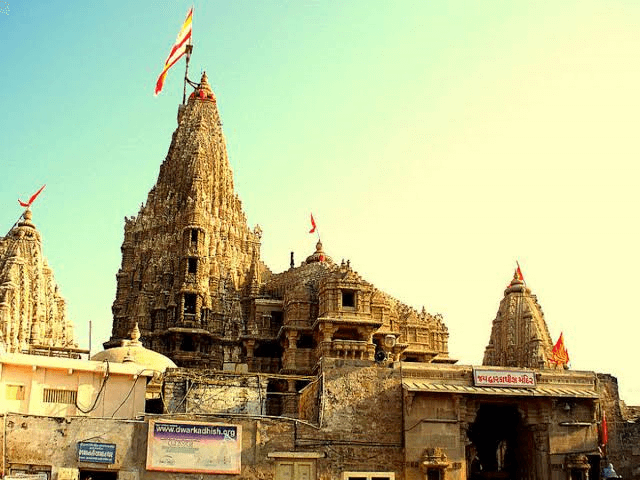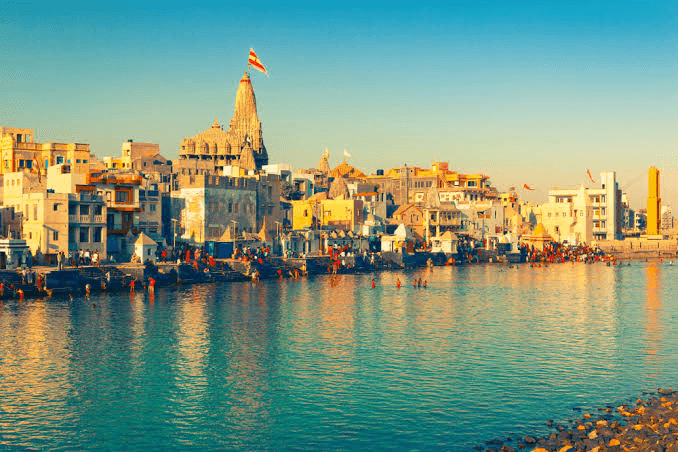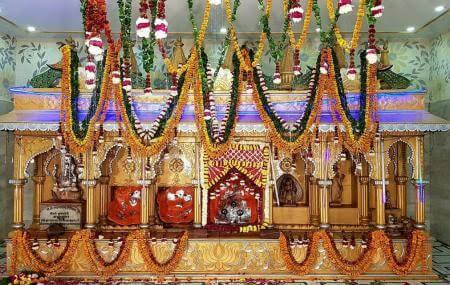Dwarkadhish TempleThe Dwarkadhish temple, commonly referred to as the Jagat Mandir and often spelt Dwarakadheesh, is a Hindu shrine to Krishna. Krishna is revered in this temple as the Dwarkadhish, or "King of Dwarka," deity. The temple is situated in Dwarka, a city in Gujarat, India, which is a stop on the Char Dham pilgrimage route. Jagat Mandir or Nija Mandir is the name of the five-story building's main shrine, which is supported by 72 pillars. Archaeological discoveries indicate that the initial temple was most likely constructed 2,200 years ago. In the 15th and 16th centuries, the temple was expanded. As a Pushtimarg temple, the Dwarkadhish Temple adheres to the rules and rites established by Vallabhacharya and Vitheleshnath. 
The original temple was thought to have been erected above Krishna's home, hari-griha, by his grandson Vajranabha, in accordance with tradition. Mahmud Begada demolished the old building in 1472, and it was later reconstructed between the 15th and 16th centuries. The temple was included in the Char Dham pilgrimage, which is important to Hindus in India. The other three are Puri, Badrinath, and Rameswaram. The Hindu philosopher and theologian Adi Shankaracharya paid a visit to the temple in the eighth century. Even today, a memorial honouring his visit may be found inside the temple. The Divya Prabandha holy writings honour Dwarakadheesh as the 98th Divya Desam of Vishnu on the subcontinent. Raja Jagat Singh Rathore rebuilt it. The temple sits 12.19 metres (40.0 feet) above average sea level and it is a west-facing temple. A garbhagriha (also known as a Nijamandira or Harigraha) and antarala make up the temple's design (an antechamber). The current temple, however, dates from the 16th century. According to Hindu mythology, Krishna reclaimed some land from the sea, and then he established Dwarka there. Once, Krishna and his wife Rukmini were guests of the sage Durvasa. The sage desired to be taken to the couple's palace. They were quick to comply and set off for their palace with the sage. Rukmini eventually became fatigued and asked Krishna for some water. Krishna is said to have created a hole that allowed the Ganges to enter the area. In a fit of rage, Sage Durvasa cursed Rukmini to stay there. It is thought that the temple where Rukmini's shrine is located was where she stood. History
In the epic of Mahabharata, the town of Dwarka in Gujarat is referred to as the Dwaraka Kingdom and has a long and illustrious history. The town is identified in tradition as the seat of Krishna and is located along the banks of the Gomti River. Several pieces of evidence, including a stone block with writing on it, the way the stones were dressed, which indicated the use of dowels, and an examination of anchors discovered on the site, indicate that the harbour site is historical in origin, with some of the underwater architecture being late medieval. The devastation of the once-thriving harbour was probably brought on by coastal erosion. Hindus have the view that Vajranabh, Krishna's great-grandson, built the first temple over his personal residence. In 1472, Sultan Mahmud Begada demolished it. The contemporary Chaulukya-style temple was built in the 15th and 16th centuries. The temple has dimensions of 27 by 21 metres, a length from east to west of 29 metres, and a breadth from north to south of 23 metres. The temple's highest summit is 51.8 metres tall. Religious Significance
This location is significant to Hindus as a place of pilgrimage since it is connected to the ancient city of Dv?rak? and the Krishna of the Mahabharata from the Vedic era. It is one of the three primary pilgrimage sites associated with the "Krishna" circuit, the other two being the 48 Kos Parikrama at Kurukshetra in the state of Haryana and the Braj Parikarma at Mathura in the state of Uttar Pradesh. The sun and moon are shown on the flag atop the temple, which is thought to be a sign that Krishna will remain there as long as the sun and moon exist on Earth. The emblem does not change even though the flag is changed up to five times each day. The temple is five stories tall and is supported by 72 pillars. The temple's spire is 78.3 metres tall. The limestone used to build the temple is still in immaculate shape. The temple has beautiful carving work created by various kingdoms that governed the area. These works did not significantly enlarge the structure. The temple has a pair of entrances. "Moksha Dwara" is the name of the major entryway (the north entrance) (Door to Salvation). One can access the main market via this entrance. The "Swarga Dwara" entrance is located in the south (Gate to Heaven). There are 56 steps outside this doorway that lead to the Gomati River. The temple is open every day from 6 a.m. to 1 p.m., and from 5 p.m. to 9 p.m. Vallaba commissioned the Krishna Janmashtami event, also known as Gokulashtami, which commemorates Krishna's birthday (1473-1531). The famous Rajput princess Meera Bai, who was also a poetess-saint and a devoted follower of Krishna, is said to have united with the god at this temple, according to tradition. It is one of India's seven holiest cities, Sapta Puri. Dvaraka Pitha, one of the four peeths (religious centres) founded by Adi Shankaracharya (686-717), was a pioneer in the unity of Hindu religious views in the nation, and is also located at the temple. It is a four-story building that stands in for the four peeths Shankaracharya founded across the nation. The walls of this place are painted with pictures of Shankaracharya's life, while the dome is covered with carvings of Shiva in various positions. Architectural StructureIt is a five-storey structure supported by 72 pillars (a sandstone temple with 60 pillars is also mentioned). The main entry door, known as the Moksha Dwar (meaning "Door to Salvation"), and the exit door, known as the Swarga Dwar, are the temple's two most significant entrances (meaning: "Gate to Heaven"). Dwarkadeesh, also known as the Trivikrama avatar of Vishnu and represented by four limbs, is the primary deity deified in the shrine. The god of Balarama, Krishna's older brother, is located in the chamber to its left. The statues of Krishna's son and grandson Pradyumna and Aniruddha are located in the room to the right. Idols represent the goddesses Radha, Jambavati, Satyabhama, and Lakshmi in the shrines that surround the main shrine. The temple also contains shrines for the sages Durvasa, Balrama, and Madhav Raoji, another name for Krishna. Just in front of the main shrine of Dwarkadhish, there are two other shrines devoted to Radha Krishna and Devaki. A very large flag bearing the images of the Sun and Moon is flown on the temple's spire, which is 78 metres (256 feet) high. The triangular flag has a length of 50 feet (15 metres). Hindus pay a tremendous number of money to hoist it by purchasing a new flag, and this flag is replaced with a new one four times per day. The funds received on this account are credited to the temple's trust fund to cover operating and maintenance costs.
Next TopicShirdi Sai Baba Temple
|
 For Videos Join Our Youtube Channel: Join Now
For Videos Join Our Youtube Channel: Join Now
Feedback
- Send your Feedback to [email protected]
Help Others, Please Share










